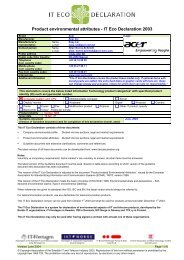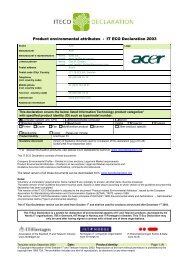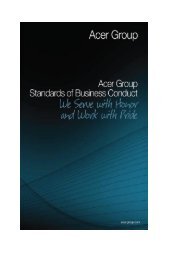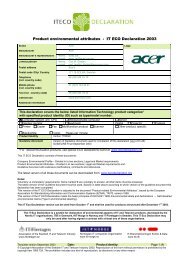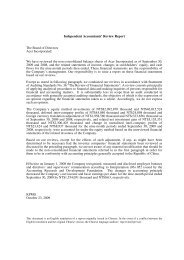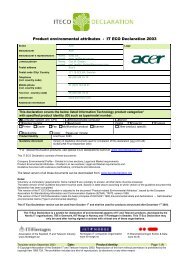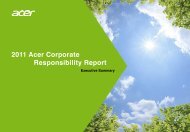Consolidated Financial Statements - Acer Group
Consolidated Financial Statements - Acer Group
Consolidated Financial Statements - Acer Group
Create successful ePaper yourself
Turn your PDF publications into a flip-book with our unique Google optimized e-Paper software.
11ACER INCORPORATED AND SUBSIDIARIESNotes to <strong>Consolidated</strong> <strong>Financial</strong> <strong>Statements</strong> (continued)Hedge accounting recognizes the offsetting effects on profit or loss of changes in the fair values of thehedging instrument and the hedged item. The designated hedging instruments that conform to thecriteria for hedge accounting are accounted for as follows:(a) Fair value hedgesChanges in the fair value of a hedging instrument designated as a fair value hedge are recognizedin profit or loss. The hedged item is also stated at fair value in respect of the risk being hedged,with any gain or loss thereon recognized in profit or loss.(b) Cash flow hedgesChanges in the fair value of a hedging instrument designated as a cash flow hedge are recognizeddirectly in equity. If a hedge of a forecasted transaction subsequently results in the recognitionof an asset or a liability, then the amount recognized in equity is reclassified into profit or loss inthe same period or periods in which the asset acquired or liability assumed affects profit or loss.(9) <strong>Financial</strong> assets carried at costEquity investments in which the <strong>Consolidated</strong> Companies cannot exercise significant influence andwhose fair value cannot be reliably measured are carried at original cost. If there is objectiveevidence which indicates that an equity investment is impaired, a loss is recognized. A subsequentreversal of such impairment loss is not allowed.(10) Notes and accounts receivable and other receivablesReceivables arising from sale of goods or rendering of services are classified as “notes and accountsreceivable”, and those arising from non-operating activities are classified as “other receivables”.Accordingly, receivables arising from sale of goods or services rendered to related parties areclassified as “notes and accounts receivable from related parties”, and those arising from loans oradvances to related parties are classified as “other receivables from related parties.”(11) Impairment for receivablesEffective January 1, 2011, the <strong>Consolidated</strong> Companies adopted the third revision of Republic ofChina Statement of <strong>Financial</strong> Accounting Standards (“SFAS”) No. 34 “<strong>Financial</strong> Instruments:Recognition and Measurement”. Under this standard, the <strong>Consolidated</strong> Companies considerevidence of impairment for receivables at both individual and collective level. All individuallysignificant receivables are assessed for specific impairment. All individually significant receivablesfound not specifically impaired are then collectively assessed for any impairment that has beenincurred but not yet identified. Receivables that are not individually significant are collectivelyassessed for impairment by grouping together receivables with similar risk characteristics. Lossesare recognized in profit or loss and reflected in an allowance account against receivables. When asubsequent event causes the amount of impairment loss to decrease, the decrease in impairment loss isreversed through profit and loss.(Continued)



